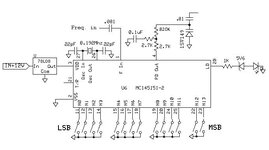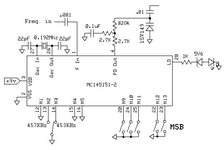neazoi
Advanced Member level 6
Please help me set this PLL switches for
A: 457KHz
B: 453KHz
Which switches do I need to close?
This is to be applied to the BFO of the FRG-7 receiver shown. Any thoughts where to connect the varicap to vary the frequency of the BFO with the minimum mods to the radio, will be appreciated.
A: 457KHz
B: 453KHz
Which switches do I need to close?
This is to be applied to the BFO of the FRG-7 receiver shown. Any thoughts where to connect the varicap to vary the frequency of the BFO with the minimum mods to the radio, will be appreciated.


